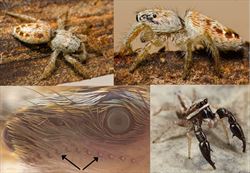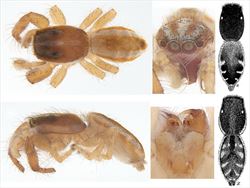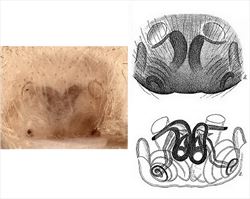
Examples of live Afraflacilla spp.
Illustrators (and ©) R. Whyte, B.J. Richardson (BL) (CSIRO), I.R. Macaulay (BR)

Aspects of the general morphology of Afraflacilla stridulator and diagrams of A. stridulator (TR) and A. huntorum (BR)
Illustrators (and ©) B.J. Richardson (CSIRO), M. Zabka (diag.)

Palp morphology of Afraflacilla stridulator
Illustrator (and ©) B.J. Richardson (L) & M. Żabka (R)

Epigyne morphology of Afraflacilla stridulator
Illustrator (and ©) B.J. Richardson and M. Żabka (diag.)
Afraflacilla Berland & Millot, 1941
Taxonomy
Afraflacilla is an Old World and African genus which extends to Australia and the western Pacific area. Australia has six species: Afraflacilla grayorum, A. gunbar, A. huntorum, A. stridulator, A. vestjensi, and A. yeni. There are many undescribed species. One Australian species, previously known as Afraflacilla milledgei, has been transferred to a new genus, Psenuc (Prószyński, 2016). Psenuc courti is also found in north Queensland (Whyte and Anderson 2017). Related Old World genera also extending to Australia include Cosmophasis and Menemerus. Further information on the genus and described species can be found in Richardson and Żabka (2017) and Whyte and Anderson (2017).
Description
Afraflacilla spp. are small to medium-sized spiders, ranging in body length from 3 to 8 mm. The cephalothorax is rectangular with curved sides when viewed from above and low to very low from the side. There is a curved row of 12 or more stridulatory tubercles extending from below the anterior lateral eye to below the posterior lateral eye. These spiny tubercles correspond with matching structures on the femur of the first leg. The tubercles on the femur are rubbed against the tubercles on the side of the head to produce sound. Chelicerae have either a single (unident) or bicuspid (fissident) tooth on the retromargin with two teeth opposite on the promargin. The abdomen is elliptical to elongate-ovate, somewhat squared-off at the front. The first pair of legs is more massive than others, sometimes huge and fat in comparison, sometimes very hairy and sometimes with a very large spur on the underneath of the enlarged tibia.
The male’s embolus is usually very long, circling the tegulum one and a half times, up to almost three times. The retro-lateral tibial apophysis is long and slender, arising from a strong, wide base and curving away from the tegulum, sometimes very widely, to a distance of half the width of the tegulum.
The female has two small, well-separated epigynal atria located some distance anterior to the epigastric fold. The highly-coiled insemination ducts lie between the atria and the epigastric fold, varying in length between species. There are no obvious spermathecae visible externally. A pair of laterally-located pockets can be seen adjacent to the epigastric fold at the posterior margins of the epigyne. These are sometimes faint or obscure.
Biology
Afraflacilla spp. are mostly observed on tree trunks, but sometimes on the ground or in foliage. Specimens are found in a variety of habitats, ranging from deserts and open woodlands to tropical coastlines. Afraflacilla gunbar and Afraflacilla stridulator have been found among nests of the social spider Phryganoporus candidus (Desidae). Some African species use stridulatory organs in both sexes and juveniles for social (communal) behaviour (Jackson 1986).
Distribution
Afraflacilla spp. are found in habitats ranging from deserts to higher rainfall areas in all mainland States and Territories.
References
Jackson, R.R. 1986. Communal jumping spiders (Araneae: Salticidae) from Kenya: interspecific nest complexes, cohabitation with web-building spiders, and intraspecific interactions. New Zealand Journal of Zoology 13, 13-26.
Prószyński, J. 2016. Delimitation and description of 19 new genera, a subgenus and a species of Salticidae (Araneae) of the world. Ecologica Montenegrina 7, 4-32.
Richardson, B.J. & Żabka, M. 2017. Salticidae. Arachnida: Araneomorphae. Canberra, Australian Faunal Directory. Australian Biological Resources Study, at https://biodiversity.org.au/afd/taxa/SALTICIDAE.
Whyte, R. & Anderson, G. 2017. A Field Guide to Spiders of Australia. CSIRO Publishing: Clayton.
Żabka, M. 1993. Salticidae (Arachnida: Araneae) of the Oriental, Australian and Pacific regions. IX. Genera Afraflacilla Berland & Millot 1941 and Evarcha Simon 1902. Invertebrate Taxonomy 7, 279-295.
Żabka, M. & Gray, M.R. 2002. Salticidae (Arachnida: Araneae) from Oriental, Australian and Pacific Regions, XVI. New species of Grayenulla and Afraflacilla. Records of the Australian Museum 54, 269-274.
* The information sheet should be interpreted in the context of the associated diagrams and photographs. Diagrams explaining anatomical terms can be found in the ‘Salticidae’ pictures at the beginning of the list of genera.